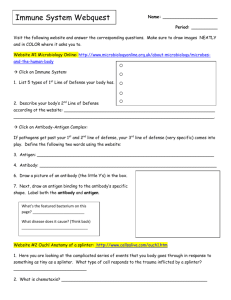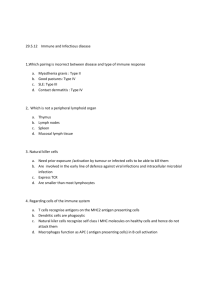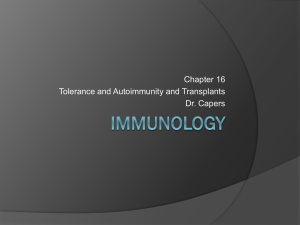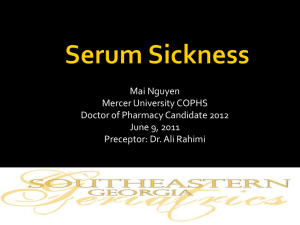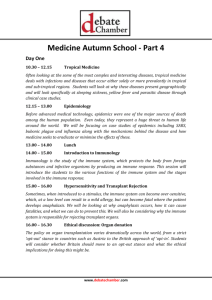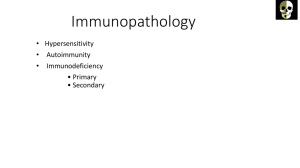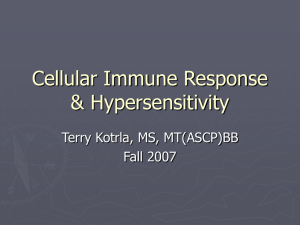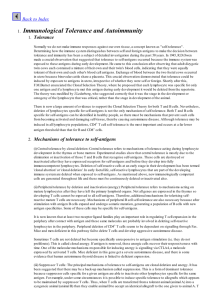Hypersensitivities
advertisement
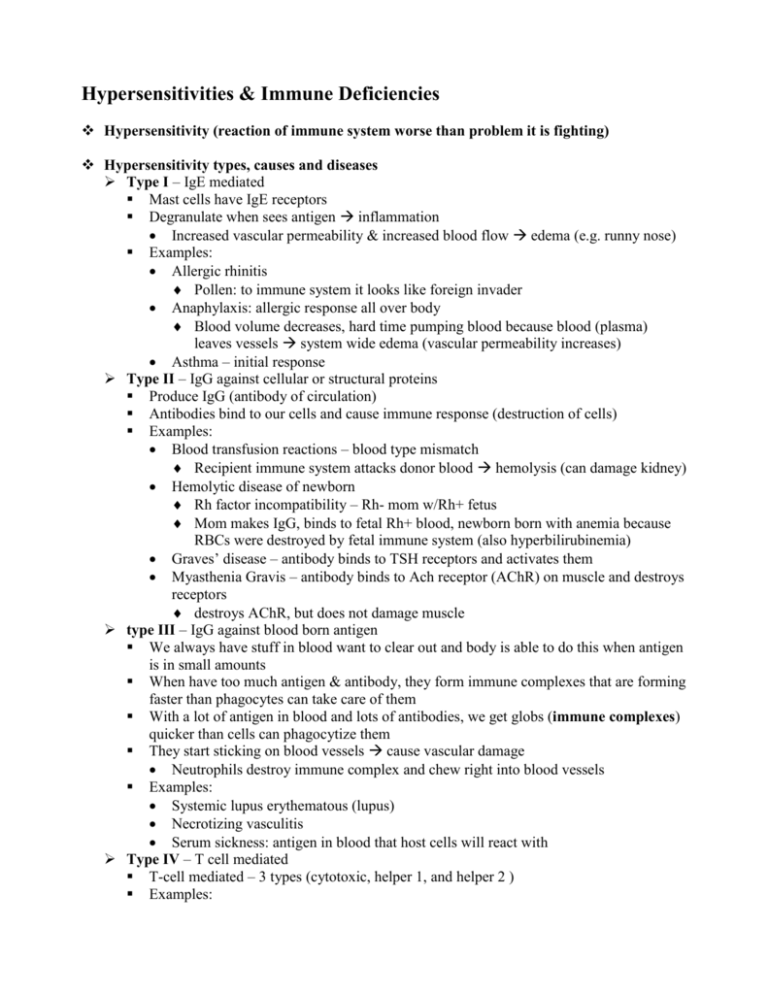
Hypersensitivities & Immune Deficiencies Hypersensitivity (reaction of immune system worse than problem it is fighting) Hypersensitivity types, causes and diseases Type I – IgE mediated Mast cells have IgE receptors Degranulate when sees antigen inflammation Increased vascular permeability & increased blood flow edema (e.g. runny nose) Examples: Allergic rhinitis Pollen: to immune system it looks like foreign invader Anaphylaxis: allergic response all over body Blood volume decreases, hard time pumping blood because blood (plasma) leaves vessels system wide edema (vascular permeability increases) Asthma – initial response Type II – IgG against cellular or structural proteins Produce IgG (antibody of circulation) Antibodies bind to our cells and cause immune response (destruction of cells) Examples: Blood transfusion reactions – blood type mismatch Recipient immune system attacks donor blood hemolysis (can damage kidney) Hemolytic disease of newborn Rh factor incompatibility – Rh- mom w/Rh+ fetus Mom makes IgG, binds to fetal Rh+ blood, newborn born with anemia because RBCs were destroyed by fetal immune system (also hyperbilirubinemia) Graves’ disease – antibody binds to TSH receptors and activates them Myasthenia Gravis – antibody binds to Ach receptor (AChR) on muscle and destroys receptors destroys AChR, but does not damage muscle type III – IgG against blood born antigen We always have stuff in blood want to clear out and body is able to do this when antigen is in small amounts When have too much antigen & antibody, they form immune complexes that are forming faster than phagocytes can take care of them With a lot of antigen in blood and lots of antibodies, we get globs (immune complexes) quicker than cells can phagocytize them They start sticking on blood vessels cause vascular damage Neutrophils destroy immune complex and chew right into blood vessels Examples: Systemic lupus erythematous (lupus) Necrotizing vasculitis Serum sickness: antigen in blood that host cells will react with Type IV – T cell mediated T-cell mediated – 3 types (cytotoxic, helper 1, and helper 2 ) Examples: Transplant rejection (body attacks as foreign tissue) Hashimoto’s thyroiditis Type I Diabetes (kills pancreatic β-cells that produce insulin) poison IV Source of antigens Environment allergies – e.g. pollen, foods, etc. Self antigen autoimmune disease – loss of proper self-tolerance Another “person” result from transplant, blood products or pregnancy the other “person” could be an animal, e.g. anti-toxin produced in a horse Examples of Hypersensitivity Diseases – allergy vs autoimmunity vs alloimmunity Type I (IgE) Allergy (environmental antigen): allergic rhinitis, anaphylaxis, asthma Autoimmunity (self antigen): rare Alloimmunity (another person’s antigens): rare Type II (tissue specific) Allergy: rare; hemolysis with penicillin (not penicillin allergic reaction; but rather penicillin binds to protein on RBCs and cells seen as foreign and destroy RBCs Autoimmunity: majority of autoimmune diseases are Type II reactions Grave’s disease, Myasthenia gravis, MS, and very many others typically result in damage to target cell, but not its destruction Alloimmunity: bad blood transfusion, hemolytic disease of newborn (antibodies from mom attacking blood of fetus), hyperacute graft rejection (host’s blood had preformed antibody against donor tissue; this is not the usual transplant rejection, very fast rejection) Type III (immune complex) Allergy: rare; wheat gluten Autoimmunity: lupus, necrotizing vasculitis Alloimmunity: serum sickness – reaction to animal antibodies (used as anti-toxins, e.g. treatment for snake bites) Type IV (T-cell mediated) Allergy: poison ivy Autoimmunity: 2nd most common type for autoimmune diseases Hashimoto’s thyroiditis, Type I Diabetes typically results in destruction of target cell Alloimmunity: transplant rejection (this is the usual delayed transplant rejection) Note: know that diseases in table are autoimmune diseases Autoimmune disease Genetic predisposition that is usually HLA linked If you have wrong HLA you have increased chance/predisposition of getting disease having wrong HLA does not guarantee autoimmune disease most people with wrong HLA are free from predisposed autoimmune disease Self-tolerance: we work fairly well at protecting our cells with checks; our immune system usually doesn’t attack us If self-reactive lymphocyte gets through will only cause damage if it is activated (environmental trigger) Once activated, undergoes clonal proliferation but it is self reactive For B cells, somatic hypermutation may cause a self-tolerant B cell to mutate into a selfreactive B cell Need genetic predisposition AND environmental trigger Systemic Lupus Erythematosus: a Type 3 hypersensitivity Antinuclear antibodies Produce antibody against double stranded DNA Wouldn’t attack cells: because DNA is inside cells and antibody can’t get to it During necrosis: cells ruptures and spill guts and DNA is floating around, antibodies bind to it and we get immune complexes and get vasculitis Butterfly rash: UV damage of skin African Americans in US are 8x more likely than whites Usually hits females in their young 20s Most autoimmune diseases tend to hit women more than they do males Leads to cellular necrosis and have self antigens in blood Activation of helper T cells and B cells specific for self-antigens Immune complexes that gather in blood Type III hypersensitivity Kidney failure is tremendous risk for lupus patients kidney has lots of capillaries kidney failure is the leading cause of death for lupus patients Immunodeficiency Primary (genetic) Lymphoid SCID (severe combined immunodeficiency) Agammaglobulinemia DiGeorge syndrome Myeloid Chronic granulomatous disease Secondary (acquired) HIV ( human immunodeficiency virus) Primary (genetic) immunodeficiency SCID (severe combined immunodeficiency): both B-cells and T-cells production affected lymph node – almost completely empty (only macrophages, dendritic cells, etc.) X-linked Agammaglobulinemia (Bruton’s) Without immunoglobulins in the blood B-cell problem (B-cells make immunoglobulins, so no B cells no immunoglobulins) lymph node – no germinal centers DiGeorge syndrome During development, pharyngeal arches do not develop properly no thymus No thymus T cell problem (don’t get any) Patients also have facial abnormalities – face also develops from pharyngeal arches Lymph node: T-cells absent empty inner cortex Phagocytic defects – many different genetic problems, we only care about: Chronic granulomatous disease Can’t make oxidative burst to make hydrogen peroxide to kill bacteria Phagocyte has bacteria sitting in it that it can’t kill Person will get lots of bacterial infections (no effects on viruses) HIV (acquired immune deficiency) Virus uses our machinery to make its own proteins carries RNA, which it converts to DNA (reverse transcription) and inserts into our DNA HIV viron looks for CD4 (T helper cell) Cell specific virus (infects Th cells) Entrance inhibitor: drug that prevents entrance of virus genetic material into CD4 cell Reverse transcriptase inhibitor: we can stop all of the reverse transcriptase going on in body and NOT cause any harm to body because we don’t have any Integrase inhibitor: prevents integration of viral DNA with our DNA HIV makes one giant protein, HIV brought in its own protease that cuts up this giant protein into multiple useful proteins Protease inhibitors prevent this Only going to effect this protease HIV infection causes loss of CD4+ helper cells helper cells are central to immune system function

